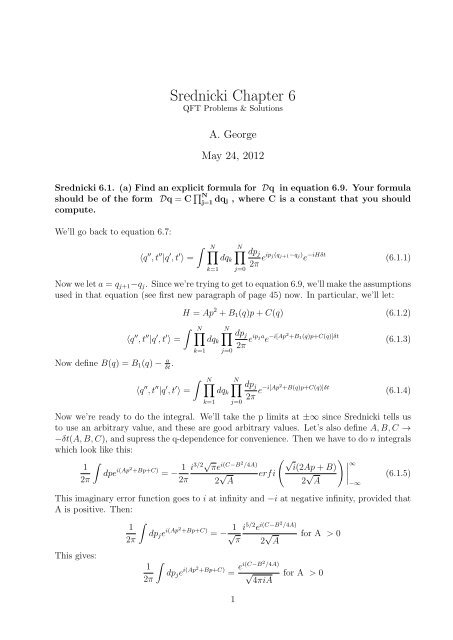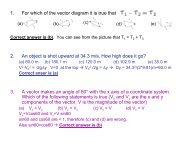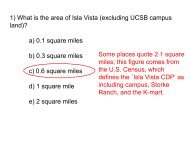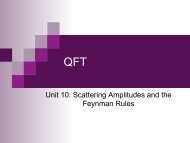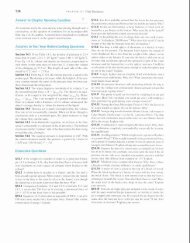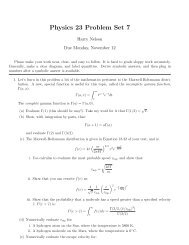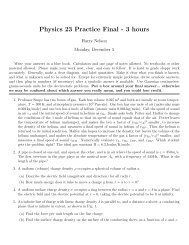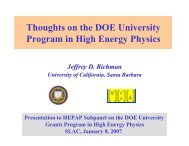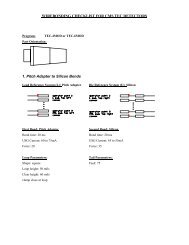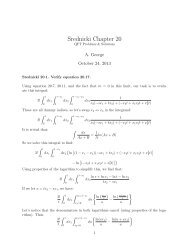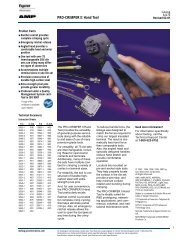Create successful ePaper yourself
Turn your PDF publications into a flip-book with our unique Google optimized e-Paper software.
Srednicki Chapter 6QFT <strong>Problems</strong> & SolutionsA. GeorgeMay 24, 2012Srednicki 6.1. (a) Find an explicit formula for Dq in equation 6.9. Your formulashould be of the form Dq = C ∏ Nj=1 dq j , where C is a constant that you shouldcompute.We’ll go back to equation 6.7:∫〈q ′′ , t ′′ |q ′ , t ′ 〉 =N∏k=1dq kN∏j=0dp j2π eip j(q j+1 −q j ) e −iHδt (6.1.1)Now we let a = q j+1 −q j . Since we’re trying to get to equation 6.9, we’ll make the assumptionsused in that equation (see first new paragraph of page 45) now. In particular, we’ll let:∫〈q ′′ , t ′′ |q ′ , t ′ 〉 =Now define B(q) = B 1 (q) − a δt .∫〈q ′′ , t ′′ |q ′ , t ′ 〉 =H = Ap 2 + B 1 (q)p + C(q) (6.1.2)N∏k=1dq kN∏k=1N∏j=0dq kdp j2π eip ja e −i[Ap2 +B 1 (q)p+C(q)]δtN∏j=0dp j2π e−i[Ap2 +B(q)p+C(q)]δt(6.1.3)(6.1.4)Now we’re ready to do the integral. We’ll take the p limits at ±∞ since Srednicki tells usto use an arbitrary value, and these are good arbitrary values. Let’s also define A, B, C →−δt(A, B, C), and supress the q-dependence for convenience. Then we have to do n integralswhich look like this:∫i 3/2√ (√ )πe i(C−B2 /4A)∣∣∣∣ ∞i(2Ap + B)12πdpe i(Ap2 +Bp+C) = − 12π2 √ Aerfi2 √ A−∞(6.1.5)This imaginary error function goes to i at infinity and −i at negative infinity, provided thatA is positive. Then:∫1dp j e i(Ap2 +Bp+C) = − 1 i 5/2 e i(C−B2 /4A)√2ππ 2 √ for A > 0AThis gives:∫12πdp j e i(Ap2 +Bp+C) = ei(C−B2 /4A)√4πiAfor A > 01
And then:∫12πdp j e i(Ap2 +Bp+C) =Now we need to do this integral N+1 times. Hence,N∏j=0∫12πdp j e i(Ap2 +Bp+C) =√e2i(C−B 2 /4A)(4πiAfor A > 0 (6.1.6)) (N+1)/2e 2i(C−B2 /4A)4πiANow we’ll put back in the factor of −δt in the A,B,C terms, as well as the q-dependence inthe B and C terms.N∏∫() (N+1)/21dp j e i(Ap2 +B(q)p+C(q)) /4A)= − e−2iδt(C(q)−B(q)22πδt4πiAj=0Now we put in the terms needed to recover (6.1.4).∫N∏k=1dq kN∏j=0∫12π dp je i(Ap2 +B(q)p+C(q)) =N∏k=1() (N+1)/2/4A)dq k − e−2iδt(C(q)−B(q)2 4πiANow we have:∫N∏k=1dq kN∏j=0∫12π dp je i(Ap2 +B(q)p+C(q)) =N∏k=1() (N+1)/2/4A)dq k i e−2iδt(C(q)−B(q)2 4πAwhich is:∫N∏k=1dq kN∏j=0∫12π dp je i(Ap2 +B(q)p+C(q)) =N∏k=1( ) (N+1)/2 i() (N+1)/2dq k e −2iδt(C(q)−B(q)2 /4A)4πANow we’re ready to use equation (6.1.4), remembering to put A → −δtA:∫〈q ′′ , t ′′ |q ′ , t ′ 〉 =N∏k=1( ) (N+1)/2 1(dq k e/4A)) N+1 −iδt(C(q)−B(q)2 (6.1.7)4iπδtABut we are being rather casual with this last term. In fact, the q’s have subscripts (the jsof equation 6.7) and the exponent is just a casual shorthand for a product over all the js.Let’s revert to using this notation:∫〈q ′′ , t ′′ |q ′ , t ′ 〉 =N∏k=1( ) (N+1)/2 1∏ Ndq k e −iδt(C(q j)−B(q j ) 2 /4A)4iπδtAj=0This can obviously be rewritten as:∫〈q ′′ , t ′′ |q ′ , t ′ 〉 =N∏k=1( ) (N+1)/2 1dq k e −iδt ∑ Nj=0 (C(q j)−B(q j ) 2 /4A)4πiδtA(6.1.8)2
Obviously this first term is the C alluded to in the problem statement.Now let’s think about the Lagrangian. The Lagrangian is given by:which is:L = p ˙q − Ap 2 − B 1 (q)p − C(q)L = p( ˙q − B 1 (q)) − Ap 2 − C(q)We use equation 6.10, which shows: p = ( ˙q − B 1 )/(2A). Then,which is:L = 2Ap 2 − Ap 2 − C(q)L = Ap 2 − C(q)( ) 2 ˙q − B1 (q)L = A− C(q)2ANow, recall that we defined B(q) = B 1 (q) − ˙q. Then,L = A( ) 2 B(q)− C(q)2AL = B(q)24ANow we’ll insert this into equation (6.1.8):∫〈q ′′ , t ′′ |q ′ , t ′ 〉 =− C(q)Dqe iδt ∑ Nk=1 LNow let δt → 0, which gives:∫〈q ′′ , t ′′ |q ′ , t ′ 〉 =Dqe i ∫ t ′′t ′ dtLwhich is Srednicki equation 6.9. Hence, we have derived the formula, and formally definedthe path integral along the way. We derived the path metric some time ago, so let me statethe result again here (from equation (6.1.7)):Dq =( ) (N+1)/2 1∏ Ndq j (6.1.9)4πiδtAj=1Note: Srednicki’s solution to this problem leaves a lot to be desired. Not only does he assumea specific form for H without any justification, but he also stops at his analog of equation(6.1.8), without proving that (6.1.8) is equivalent to Srednicki equation 6.9.(b) In the case of a free particle, V(Q) = 0, evaluate the path integral of equation6.9 explicitly. Hint: Integrate over q 1 , then q 2 , etc., and look for a pattern.Express your final answer in terms of q’, t’, q”, t”, and m. Restore ¯h by dimensionalanalysis.3
We’ll go back to (6.1.8):∫〈q ′′ , t ′′ |q ′ , t ′ 〉 =Dqe −iδt ∑ Nk=1 (C(q k)−B(q k ) 2 /4A)In this case, A = 1 , B 2m 1 = 0, C = 0. We can calculate B = − ˙q. Then:∫〈q ′′ , t ′′ |q ′ , t ′ 〉 = Dqe − im 2 δt ∑ Nk=1 q˙k 2It’s a little bit difficult to deal with the derivative, so let’s write in long form.∫〈q ′′ , t ′′ |q ′ , t ′ 〉 = Dqe − im ∑ N (q j+1 −q j ) 22 j=0 δtUsing equation (6.1.9):〈q ′′ , t ′′ |q ′ , t ′ 〉 =∫ ( ) (N+1)/2 2m ∏ Ndq j e − im 24πiδtj=1Taking advantage of the hint, we’ll do the q 1 integral:∫dq 1 e iC(q 2−q 1 ) 2 e iC(q 1−q 0 ) 2where C = −m/(2δt).∑ N (q j+1 −q j ) 2j=0 δtWe’ll expand these products:∫dq 1 e iC(2q2 1 −2q 1(q 2 +q 0 )+(q 2 2 +q2 0 ))This is of the form of equation (6.1.6). Now:∫√dq 1 e iC(q 2−q 1 ) 2 e iC(q 1−q 0 ) π2=iC 2iC e− 2 (q 2−q 0 ) 2which is:∫√dq 1 e iC(q 2−q 1 ) 2 e iC(q 1−q 0 ) π2=iC 2iC e− 2 (q 2−q 0 ) 2and then:∫√dq 1 e iC(q 2−q 1 ) 2 e iC(q 1−q 0 ) iπδt2=iC m e− 2 (q 2−q 0 ) 2Now for the q 2 integral. I won’t show all the calculus since it’s the same as before, the resultis:∫√dq 2 e iC(q 3−q 2 ) 2 e iC 2 (q 2−q 0 ) 4iπδt2=iC 3m e− 3 (q 3−q 0 ) 2At some point we see the pattern. We increase the integer in the denominator of the expononent,and weigh the factor in the coefficient accordingly. The result is:∫dq N e iC(q 3−q 2 ) 2 e iC 2 (q 2−q 0 ) 2 =4√N2iπδt iCe− N+1 (q N+1−q 0 ) 2(N + 1)m
Back to equation (6.1.9), plugging in our solutions for all the integrals:( √( m) N)(N+1)/2 ∏〈q ′′ , t ′′ |q ′ , t ′ ji2πδt〉 =2πiδt(j + 1)mj=1e − iCj+1 (q j+1−q 0 ) 2Note that the product acts only on the coefficient in front of the exponential, not on theexponential itself (this is because the entire q n−1 exponential was used to construct the q nexponential, and so forth). As for the prefactors, everything cancels except the N + 1 term(and the 1 term, but that is obviously unimportant). Then:〈q ′′ , t ′′ |q ′ , t ′ 〉 =( m) (N+1)/2 12πiδt√N + 1( i2πδtm) N/2e − iCN+1 (q N+1−q 0 ) 2which simplifies to:√〈q ′′ , t ′′ |q ′ , t ′ m〉 =(N + 1)2πiδt e im(N+1)2δt (q N+1−q 0 ) 2and then:√〈q ′′ , t ′′ |q ′ , t ′ m〉 =2πi(t ′′ − t ′ ) e im 2(q ′′ −q ′ ) 2t ′′ −t ′where we noted that q 0 = q ′ and q N+1 = q ′′ . Now to restore the factors of ¯h. The exponentneeds to be dimensionless, but it currently has units of Et. So we divide by ¯h.√〈q ′′ , t ′′ |q ′ , t ′ m〉 =2πi(t ′′ − t ′ ) e im (q ′′ −q ′ ) 22¯h t ′′ −t ′What units should the prefactor have? If we set t ′ = t ′′ , then we obviously have 〈q ′′ |q ′ 〉 =δ(q ′′ − q ′ ). This will get rid of one length unit, so it has dimensions of inverse length. Inthe prefactor given, we should therefore divide by ¯h. This will give units of (s 2 ) −1/2 = s −1 ,which becomes inverse length when multiplied by c (and we are not told to restore the cs.Then,√〈q ′′ , t ′′ |q ′ , t ′ 〉 =m2πi¯h(t ′′ − t ′ ) e im2¯h(q ′′ −q ′ ) 2t ′′ −t ′ (6.1.10)(c) Compute 〈q ′′ , t ′′ |q ′ , t ′ 〉 = 〈q ′′ |e −iH(t′′ −t ′) |q ′ 〉 by inserting a complete set of momentumeigenstates, and performing the integral over the momentum. Comparewith your result from part (b).〈q ′′ , t ′′ |q ′ , t ′ 〉 = 〈q ′′ |e −iH(t′′ −t ′) |q ′ 〉Inserting the complete set of momentum eigenstates:〈q ′′ , t ′′ |q ′ , t ′ 〉 =∫ ∞−∞dp〈q ′′ |e −iH(t′′ −t ′) |p〉〈p|q ′ 〉The bra-ket on the right is easy to evaluate. The Hamiltonian for a free particle is given byH = P2 . So: 2m ∫ ∞〈q ′′ , t ′′ |q ′ , t ′ 〉 = dp〈q ′′ |e −i(t′′ −t ′ ) P2 12m |p〉 √ e −ipq′−∞2π5
The momentum operator acting on the momentum eigenstate will give the momentum eigenvalue,which we’ll call p. Then,〈q ′′ , t ′′ |q ′ , t ′ 〉 = 1 √2π∫ ∞−∞dp〈q ′′ |e −i(t′′ −t ′ ) p22m |p〉e−ipq ′Now the operator between the bra and the ket is just a constant, so we can take it out:which is:〈q ′′ , t ′′ |q ′ , t ′ 〉 = 1 √2π∫ ∞−∞〈q ′′ , t ′′ |q ′ , t ′ 〉 = 1 ∫ ∞2π〈q ′′ , t ′′ |q ′ , t ′ 〉 = 12π−∞∫ ∞−∞dpe −i(t′′ −t ′ ) p22m 〈q ′′ |p〉e −ipq′dpe p2 −i(t ′′ −t ′ )2m e −ip(q′ −q ′′ )[dpe i p 2 −(t ′′ −t ′ ])2m −p(q′ −q ′′ )This is of the form of equation (6.1.6), but this time A is negative. The result is that inequation (6.1.5), we get −2i rather than 2i from the imaginary error function. As a result,equation (6.1.6) has the i in the numerator rather than the denominator. Using this result,we have:√〈q ′′ , t ′′ |q ′ , t ′ m〉 =2πi(t ′′ − t ′ ) e im 2(q ′′ −q ′ ) 2t ′′ −t ′which is the same as our result from part b, equation (6.1.10), once we add in the factors of¯h as before.6


